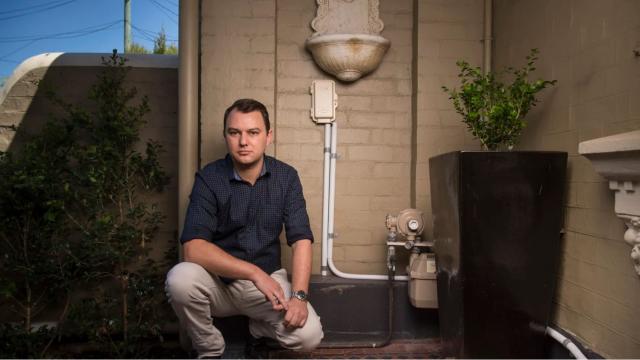The company delivering the National Broadband Network has offered an apology to property owners unhappy with the installation of equipment, as criticism mounts about the rollout of the network.
Stanmore resident Daniel Ribarovski said NBN Co’s contractors dug up the front yard of his 1880s Victorian terrace while he was overseas, triggering a security alert to his phone.
“They subsequently drilled into my nearly 140-year-old house and stuck the box in an eyesore of a position directly beneath a water feature,” he said. “I was in absolute shock when I walked up the front stairs and saw this monstrosity on my verandah.”
Mr Ribarovski said he was initially fobbed off by NBN Co, which took several months to deal with his complaints.
“I’m pretty annoyed that these people are permitted to show up at my property when I’m not home and without any notice, rip up my front yard, drill into my house and stick a giant eyesore on to it in particularly shoddy fashion,” he said. “And then throw their hands in the air and say ‘not my problem’.”
A spokeswoman for Vodafone, Mr Ribarovski’s internet service provider, said the installation had not followed guidelines set by NBN Co.
“An appointment for an NBN technician to carry out Mr Ribarovski’s NBN installation was made on his behalf by Vodafone for 16 September,” she said. “Without our knowledge, or the customer’s knowledge, the work was done outside the agreed timeframe.”
An NBN Co spokesman said equipment was installed correctly 92 per cent of the time.
“A project of this scale and size is never going to be problem free, and we apologise to residents who haven’t had a positive NBN connection experience,” he said.
Phone carriers, including NBN Co, are permitted to install equipment without the express consent of a property owner, although the law requires that property owners are notified and given potential dates.
“The type of technology will determine the level of construction and subsequent installation, which, in some cases, does not require residents to be present,” the NBN Co spokesman said.
The $50 billion National Broadband Network entered its final rollout year promising improved internet speeds that will narrow the productivity gap between small and big business.
However, the rollout has been plagued with complaints from consumers claiming poor speeds, frequent outages and a lack of affordability.
The Telecommunications Industry Ombudsman (TIO) recorded the most complaints about internet services in the first quarter of the 2020 financial year.
A TIO spokeswoman said the ombudsman handled complaints about the location of equipment and property damaged in the course of installation, which were usually resolved
“fairly quickly” by agreement.
“Land owners can ask NBN Co to move or remove equipment, but may have to pay the cost of doing this,” she said. “It usually depends on whether the installation meets the applicable standards.”
Separately, Tooran Alizadeh, a senior lecturer in urban technology planning at the University of Sydney, presented a paper at a conference in Perth earlier this month which said the rollout of inferior technology in Sydney and Melbourne was “quite shocking”.
Dr Alizadeh’s co-authored paper, Socio-Spatial Patterns of the NBN Rollout: It is worse than what you think, found the wealthiest parts of Sydney and lowest socio-economic areas in Melbourne had the lowest proportion of the most advanced technology available on the NBN platform.
Research suggests about 50 per cent of homes in Sydney and Melbourne only have access to ageing technology known as hybrid fibre-coaxial (HFC).
“[F]or about half of the population in both major Australian metropolitan regions, the NBN looks like a rebranding exercise using an old cable network,” the paper said.
But an NBN Co spokesman questioned the paper’s finding, and said customers on HFC connections received, on average, similar internet speeds as those consumers with fibre-to-the-premises technology.
“Hybrid Fibre Coaxial (HFC) technology is used around the world to deliver high-speed broadband services to tens of millions of customers,” he said.
This article originally appeared in Digital Life, The Sydney Morning Herald’s home for everything technology. Follow Digital Life on Facebook and Twitter.
